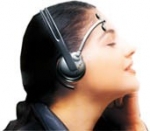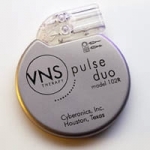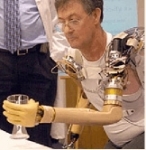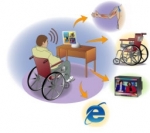Sep 16, 2005
Non-invasive neural interface technology
Via Engadget (thanks to Giuseppe Riva)
NeuroSky Inc. claims to have developed a non-invasive neural sensor and signal processing technology that converts brainwaves and eye movements into electronic signals to control a range of electronic devices.
According to Neurosky, neural interface technology promises to simplify cell phone-based applications that today require error-prone human input, as well as revolutionize applications from gaming to medical diagnostics and therapy.
 EETimes reports that five companies, including a Bluetooth headset provider, game console maker and trucking company, have signed up to market end-user products containing NeuroSky's chips.
EETimes reports that five companies, including a Bluetooth headset provider, game console maker and trucking company, have signed up to market end-user products containing NeuroSky's chips.
From the company website:
NeuroSky, a fabless semiconductor/module company, has developed a non-invasive neural sensor and signal processing technology that converts brainwaves and eye movements into useful electronic signals to communicate with a wide range of electronic devices, consoles, and computers. While brainwaves have been used as a form of diagnostics and therapy in neurosciences for years, the related technology has never reached a large audience due to price/size constraints, inconvenient physical limitations, and/or invasive surgical procedures. NeuroSky draws from this research and adapts it to commercialize neural interface technologies for various attractive global markets.
More to explore
13:00 Posted in Brain-computer interface | Permalink | Comments (0) | Tags: Positive Technology, brain-computer interface
Aug 03, 2005
Downloading video from the brain
Using cats selected for their sharp vision, in 1999 Garret Stanley and his team recorded signals from a total of 177 cells in the lateral geniculate nucleus - a part of the brain's thalamus (the thalamus integrates all of the brains sensory input and forms the base of the seven-layered thalamocortical loop with the six layered neocortex) - as they played 16 second digitized (64 by 64 pixels) movies of indoor and outdoor scenes.
 Using simple mathematical filters, Dr. Stanley and his colleagues decoded the signals to generate movies of what the cats actually saw. This finding has enormous implications in the fields of neurorehabilitation and neural repair. For example, it could allow to wire artificial limbs directly into the brain, or to develop artificial brain extensions.
Using simple mathematical filters, Dr. Stanley and his colleagues decoded the signals to generate movies of what the cats actually saw. This finding has enormous implications in the fields of neurorehabilitation and neural repair. For example, it could allow to wire artificial limbs directly into the brain, or to develop artificial brain extensions.
More to explore
Garrett B. Stanley, Fei F. Li, and Yang Dan, Reconstruction of Natural Scenes from Ensemble Responses in the Lateral Geniculate Nucleus. Journal of Neuroscience, 1999; 19: 8036 - 8042 Link to the full-text PDF
20:10 Posted in Brain-computer interface | Permalink | Comments (0) | Tags: Positive Technology, brain-computer interface
Jul 19, 2005
Vagus Nerve Stimulation System for Severe Depression
Via Medgadget
The Food and Drug Administration has recently approved a new treatment for severe depression based on a nerve stimulation system that delivers tiny electric shocks through vagus nerve and into a region of the brain thought to play a role in mood.
 Cyberonics Inc.'s stimulation system is an adjunctive long-term treatment of chronic or recurrent depression for adults who are experiencing a major depressive episode that has not had an adequate response to two or more adequate antidepressant treatments.
Cyberonics Inc.'s stimulation system is an adjunctive long-term treatment of chronic or recurrent depression for adults who are experiencing a major depressive episode that has not had an adequate response to two or more adequate antidepressant treatments.
Despite controversy over whether it's really been proven to work, the potential treatment targets an estimated 4 million Americans with hard-to-treat depression.
12:00 Posted in Brain-computer interface | Permalink | Comments (0) | Tags: Positive Technology, brain-computer interface
Jun 29, 2005
Bionic Arm Technology is advancing
From Medgadget
Mr. Jesse Sullivan is the world's first "Bionic Man", according to the Rehabilitation Institute of Chicago (RIC). In May 2001, Mr. Sullivan lost both of his upper extremities as a result of an accident. The technology that allows this patient to control his artificial arms has been developed by RIC's Neural Engineering Center for Artificial Limbs (NECAL).
Developed within the Neural Engineering Center for Artificial Limbs (NECAL) at RIC, Dr. Todd Kuiken, MD, PhD, pioneered the muscle reinnervation procedure which takes an amputee's own nerves and connects them to a healthy muscle. In this case, four of Mr. Sullivan's nerves were dissected from the shoulder and transferred to the muscles of his chest. Doing so allows the user to move his or her prosthetic arm as if it were a real limb--by simply thinking about what they want the arm to do. The "Bionic Arm," or myoelectric arm, is driven using electrical signals from the muscles of the chest, now activated by the user's own thought-generated nerve impulses. These impulses are sensed, via surface electrodes, from the pectoral muscle and carried through to the mechanical arm, causing the arm to move.

NECAL uses nerve-muscle grafts in amputees to gain added control signals for an artificial arm. Doctors take nerves that used to go to the arm and move those nerves onto chest muscles. The nerves grow into the chest muscles, so when the patient thinks "close hand," a portion of his chest muscle contracts and electrodes that detect this muscle activity tell the computerized arm when to close the hand. Thus, the patient thinks "close hand" and his artificial hand closes...
Researchers at RIC have learned that although the limb is lost with an amputation, the control signals to that limb remain accessible in the residual peripheral nerves. Grafting the residual nerves of an upper-limb amputee to spare muscles produces additional control signals, allowing for simultaneous operation of multiple functions in an externally powered prosthesis with a more natural feel than is possible with conventional prostheses.
The "Bionic Arm" technology has been very successful so far in both significantly improving the function of artificial limbs as well as allowing the skin to be reinnervated with nerves form the arm. The first patient to undergo the new procedure, Jesse Sullivan, has experienced significant improvements in the functioning of his prosthetic arms. While previously moving his artificial arms was slow and cumbersome, today he is able to do many of the routine tasks he took for granted before his accident, including putting on socks, shaving, eating dinner, taking out the garbage, carrying groceries and vacuuming.
18:35 Posted in Brain-computer interface | Permalink | Comments (0) | Tags: brain-computer interface
Apr 28, 2005
Brain-machine Interface Test Promising
From Betterhumans
An experimental brain-machine interface has allowed a quadriplegic person to control a computer in what could be an early step to new assistive technologies for the disabled.

Cyberkinetics of Foxborough, Massachusetts has reported preliminary results for a pilot study of its BrainGate Neural Interface System, which the company aims to develop into a safe, effective and unobtrusive universal operating system for allowing disabled people to control devices using their thoughts.
"While these results are preliminary, I am extremely encouraged by what has been achieved to date," says study investigator Jon Mukand of Sargent Rehabilitation Center. "We now have early evidence that a person unable to move their arms, hands and legs can quickly gain control of a system which uses thoughts to control a computer and perform meaningful tasks. With additional development this may represent a significant breakthrough for people with severe disabilities."
Mental link
BrainGate, in a pilot study under a US Food and Drug Administration Investigational Device Exemption, uses an implanted neural signal sensor and external processors to allow users to control machinery.
The implanted sensor is about the size of a baby aspirin and contains 100 electrode probes thinner than a human hair. Implanted in part of the brain responsible for movement, the primary motor cortex, the probes detect the electrical activity of brain cells and relay this through a small wire exiting the scalp to a pedestal on the skull. A cable runs from the pedestal to a cart with computers, signal processors and monitors, allowing operators to study how well users can control their neural output.
For the reported study, an unidentified quadriplegic person with a three-year-old spinal cord injury had the sensor implanted this June in an approximately three-hour operation at Rhode Island Hospital in Providence. The procedure reportedly went as planned and the recipient has reportedly experienced no side-effects or problems healing.
Interactive mind
The study examined the recipient's use of BrainGate over two months and 20 study sessions. It found that the recipient could immediately adjust neural output in response to commands. It also found that a computer interface developed using the patient's thoughts allowed the subject to perform tasks and operate basic computer functions, including controlling a cursor, playing Pong with 70% accuracy and performing multiple tasks simultaneously, such as controlling a TV while talking.
While the findings are preliminary and based on a single patient, Cyberkinetics aims to enroll a total of five quadriplegic people between the ages of 18 and 60 who meet such criteria as being able to verbally communicate.
Each participant is expected to participate in a study for 13 months. Afterwards, participants can undergo surgery to have the device removed or choose to participate in future studies, which the first patient has chosen to do.
"Our ultimate goal is to develop the BrainGate System so that it can be linked to many useful devices, including for example, medical devices such as muscle stimulators, to give the physically disabled a significant improvement in their ability to interact with the world around them," says John Donoghue, chief scientific officer of Cyberkinetics.
The research was reported in Phoenix, Arizona at the 2004 annual meeting of the American Academy of Physical Medicine and Rehabilitation.
Cyberkinetics plans to announce more results and observations from the pilot study in San Diego, California at the 2004 annual meeting of the Society for Neuroscience.
14:45 Posted in Brain-computer interface | Permalink | Comments (0) | Tags: Positive Technology, brain-computer interface






